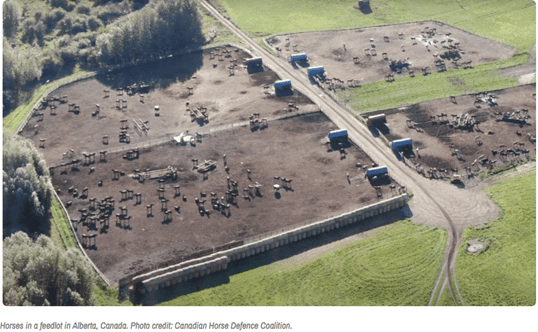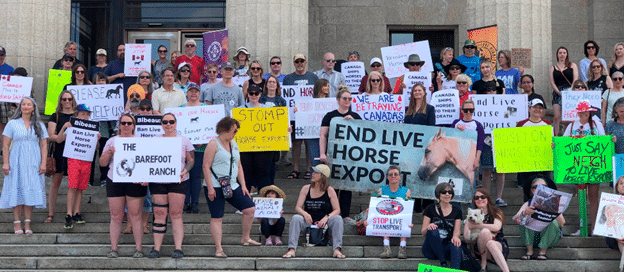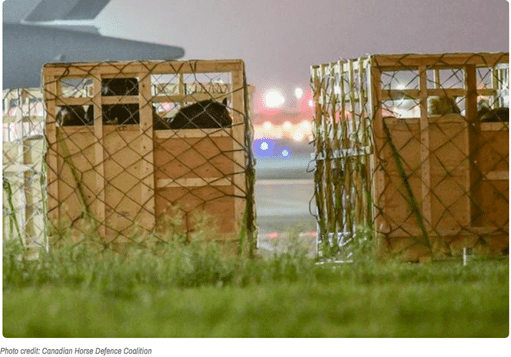Horse Exportation in Canada
Take Action: Bill C-355, an act prohibiting exporting horses by air for slaughter, began its second reading in the House of Commons. Contact your MP to ensure this federal bill goes through.
Canada’s Horse Exportation Industry at a Glance
– Canada is one of the only countries in the world that breeds, raises, and transports horses overseas for slaughter to fill the demand for fresh horse meat.
– Canada’s horse exportation industry ships thousands of horses overseas for slaughter every year. Here are the most recent stats.
– More than 40,000 draft horses have been exported out of Canada since 2013.
– Draft horses are purposely bred for exportation and are shipped out Edmonton, Calgary, and Winnipeg’s airports.
– Horses are raised in barren feedlots without sufficient protection from the elements.

– Horses can endure 30+ hours travel time from the moment they’re loaded onto the trailer at the feedlot to the time they land in Japan, often exceeding Canada’s Federal Health of Animals regulations, which state horses are not to be transported for longer than 28 hours without food water or rest.
– Horses are randomly paired into cramped wooden crates, a direct violation of Canada’s Federal Health of Animals regulations which state any horse over 14 hands must be segregated during transport. A point challenged by the Canadian Horse Defense Coalition in a 2019 lawsuit against the CFIA.
– Horses panic easily, have strong fight or flight instincts, and have extremely sensitive hearing, making air transportation incredibly stressful for them.
– Canada’s privately owned and run horse $8 million exportation industry is not economically justifiable, as it is of no benefit to the Canadian public.
– Once horses arrive in Japan, there is no way to know how they are treated, how long they are housed before slaughter, and how they are slaughtered.
– Horses are slaughtered for sashimi which is not a staple food in Japanese diets, rather a wealthy delicacy for a niche market.
– Multiple deaths and injuries have been reported during the loading and transport process, as well as reported deaths once horses are held in feedlots in Japan.
Recent timeline in the fight to end Canada’s live horse export
Due to animal welfare concerns, the Canadian Horse Defence Coalition (CHDC) has been advocating for a ban on live horse export since 2012. Over the last few years, Canadian SPCAS such as the Winnipeg Humane Society and BC SPCA have joined the fight to ban this cruel practice.
– February 2021: the CHDC initiated a federal petition e-3187 calling upon the government to stop air shipments of horses exported for human consumption, due to ongoing animal welfare concerns. With 77, 684 signatures, the petition received more public support than any other parliamentary petition for animals.
– September 2021: The Liberal Party pledges to ban live horse export for slaughter in their federal election campaign
– December 2021: Prime Minister Trudeau sends mandate letter to the Minister of Agriculture and Agri-Food, which includes banning the live export of horses for slaughter.
– June 2022: The WHS holds a Rally to Ban the Live Export of Horses for slaughter at the Manitoba Legislative building.

– November 2022: CHDC and Jann Arden initiate another federal petition e-4190, calling on the Minister of Agriculture and Agri-Food to halt the live export of horses for slaughter, consistent with the Minister’s mandate letter.
– February 2023: Petition e-4190 closed with a total of 36,175 signatures and is presented to the House of Commons by MP Alistair MacGregor.
– March 2023: Government response to petition e-4190 was tabled, stating they are working to implement the mandate letter to ban live horse export.
– June 2023: Backed by Canadian icon Jann Arden, Senator Pierre Dalphond introduces Bill S-270 to Senate to prohibit live horse export.
– September 2023: Liberal MP Tim Louis introduces Private Member’s Bill C-355 to the House of Commons to prohibit the export of horses for slaughter. The Prime Minister’s Office has expressed their support for this bill.
– November 2023: Bill C-355 begins its second reading in the House of Commons.
– April 2024: Bill C-355 passes Agriculture Committee with amendments

Bill C-355 Current Progress
On November 20, 2023 – Bill C-355, an act to stop the export of live horses by air for the purpose of slaughter, began its second reading in the House of Commons. MP Tim Louis’ opened the reading by educating his fellow Members of Parliament about the cruelty inherent in the live horse export trade and what horses mean to Canadians. A vigorous debate followed including a powerful speech in support of the bill from MP for Winnipeg South, Ben Carr.
The debate on this issue is NOT completed; a new date will be announced when it becomes available. Bill C-355 will be voted on after the period of debating is over. A majority of votes in favour of the bill will propel it to the next stage to be considered by the Agriculture Committee.
TAKE ACTION!
Let’s make sure that Bill C-355 gets the votes required to pass. Here’s how you can help:
– Contact your MP. You can find yours here.
– Check out the WHS guide on how to set up a meeting with your political representatives.
– Not sure what to say to your political rep? Use the WHS Blog: 16 Animal Welfare Risks Associated with Horse Exportation, to inform your dialogue:
– Use our letter template to write Agriculture Minister MacAulay and Prime Minister Trudeau
The Honourable Lawrence MacAulay
House of Commons
Ottawa, Ontario,
Canada
K1A 0A6
613-995-9325
Email: [email protected]
Prime Minister Justin Trudeau
House of Commons
Ottawa, Ontario,
Canada
K1A 0A6
Telephone: 613-992-4211
Fax: 613-947-0310
Email: [email protected]
Additional Resources
History of Horse Exportation from 1990-2021
Horses are Still Being Exported for Slaughter. Will Trudeau Take Action?
HorseShit: Jann Arden’s Horse Exportation Campaign
‘The ultimate betrayal’: Winnipeg Humane Society calls for feds to ban live horse exportation
WHS Video Explaining Horse Exportation
W5: A glimpse inside Canada’s ‘sinister’ horse meat industry
A contentious export: The anatomy of Canada’s horsemeat industry
WHS Blog Post: Canada’s Unwanted Horses: Is Slaughter Really the Solution
If you have further questions, contact [email protected].

